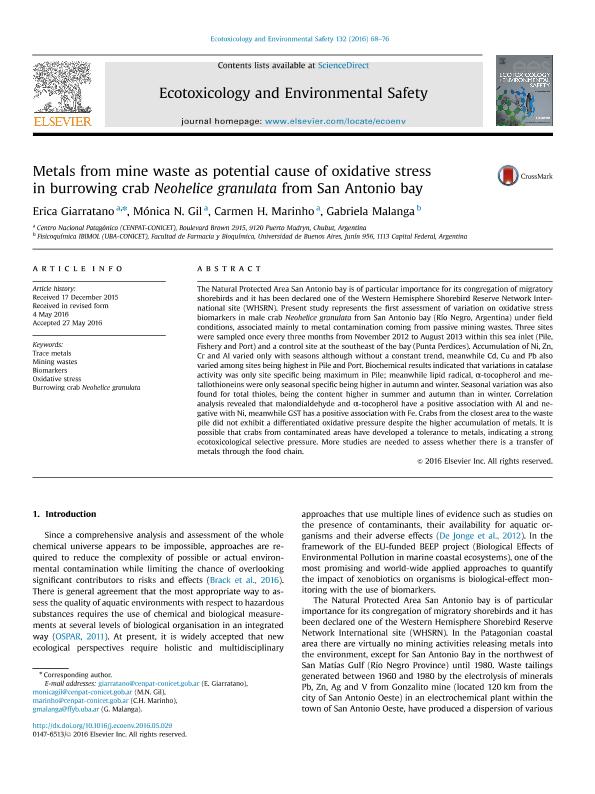Mostrar el registro sencillo del ítem
dc.contributor.author
Giarratano, Erica

dc.contributor.author
Gil, Monica Noemi

dc.contributor.author
Marinho, Carmen Haydee

dc.contributor.author
Malanga, Gabriela Fabiana

dc.date.available
2018-03-05T18:49:31Z
dc.date.issued
2016-10
dc.identifier.citation
Giarratano, Erica; Gil, Monica Noemi; Marinho, Carmen Haydee; Malanga, Gabriela Fabiana; Metals from mine waste as potential cause of oxidative stress in burrowing crab Neohelice granulata from San Antonio bay; Academic Press Inc Elsevier Science; Ecotoxicology and Environmental Safety; 132; 10-2016; 68-76
dc.identifier.issn
0147-6513
dc.identifier.uri
http://hdl.handle.net/11336/37826
dc.description.abstract
The Natural Protected Area San Antonio bay is of particular importance for its congregation of migratory shorebirds and it has been declared one of the Western Hemisphere Shorebird Reserve Network International site (WHSRN). Present study represents the first assessment of variation on oxidative stress biomarkers in male crab Neohelice granulata from San Antonio bay (Río Negro, Argentina) under field conditions, associated mainly to metal contamination coming from passive mining wastes. Three sites were sampled once every three months from November 2012 to August 2013 within this sea inlet (Pile, Fishery and Port) and a control site at the southeast of the bay (Punta Perdices). Accumulation of Ni, Zn, Cr and Al varied only with seasons although without a constant trend, meanwhile Cd, Cu and Pb also varied among sites being highest in Pile and Port. Biochemical results indicated that variations in catalase activity was only site specific being maximum in Pile; meanwhile lipid radical, α-tocopherol and metallothioneins were only seasonal specific being higher in autumn and winter. Seasonal variation was also found for total thioles, being the content higher in summer and autumn than in winter. Correlation analysis revealed that malondialdehyde and α-tocopherol have a positive association with Al and negative with Ni, meanwhile GST has a positive association with Fe. Crabs from the closest area to the waste pile did not exhibit a differentiated oxidative pressure despite the higher accumulation of metals. It is possible that crabs from contaminated areas have developed a tolerance to metals, indicating a strong ecotoxicological selective pressure. More studies are needed to assess whether there is a transfer of metals through the food chain.
dc.format
application/pdf
dc.language.iso
eng
dc.publisher
Academic Press Inc Elsevier Science

dc.rights
info:eu-repo/semantics/openAccess
dc.rights.uri
https://creativecommons.org/licenses/by-nc-nd/2.5/ar/
dc.subject
BIOMARKERS
dc.subject
BURROWING CRAB NEOHELICE GRANULATA
dc.subject
MINING WASTES
dc.subject
OXIDATIVE STRESS
dc.subject
TRACE METALS
dc.subject.classification
Meteorología y Ciencias Atmosféricas

dc.subject.classification
Ciencias de la Tierra y relacionadas con el Medio Ambiente

dc.subject.classification
CIENCIAS NATURALES Y EXACTAS

dc.title
Metals from mine waste as potential cause of oxidative stress in burrowing crab Neohelice granulata from San Antonio bay
dc.type
info:eu-repo/semantics/article
dc.type
info:ar-repo/semantics/artículo
dc.type
info:eu-repo/semantics/publishedVersion
dc.date.updated
2018-03-02T15:00:36Z
dc.journal.volume
132
dc.journal.pagination
68-76
dc.journal.pais
Países Bajos

dc.journal.ciudad
Amsterdam
dc.description.fil
Fil: Giarratano, Erica. Consejo Nacional de Investigaciones Científicas y Técnicas. Centro Nacional Patagónico; Argentina
dc.description.fil
Fil: Gil, Monica Noemi. Consejo Nacional de Investigaciones Científicas y Técnicas. Centro Nacional Patagónico; Argentina
dc.description.fil
Fil: Marinho, Carmen Haydee. Consejo Nacional de Investigaciones Científicas y Técnicas. Centro Nacional Patagónico; Argentina
dc.description.fil
Fil: Malanga, Gabriela Fabiana. Consejo Nacional de Investigaciones Científicas y Técnicas. Oficina de Coordinación Administrativa Houssay. Instituto de Bioquímica y Medicina Molecular. Universidad de Buenos Aires. Facultad de Farmacia y Bioquímica. Instituto de Bioquímica y Medicina Molecular; Argentina
dc.journal.title
Ecotoxicology and Environmental Safety

dc.relation.alternativeid
info:eu-repo/semantics/altIdentifier/url/https://www.sciencedirect.com/science/article/pii/S0147651316301981
dc.relation.alternativeid
info:eu-repo/semantics/altIdentifier/doi/http://dx.doi.org/10.1016/j.ecoenv.2016.05.029
Archivos asociados
